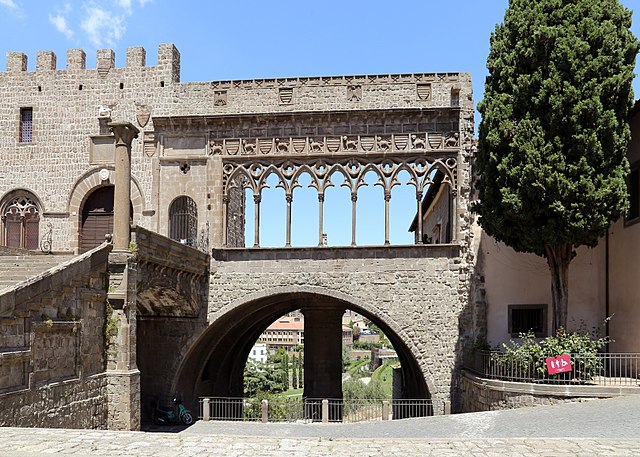Palace of the Popes in Viterbo
From Wikipedia, the free encyclopedia
From Wikipedia, the free encyclopedia
Palazzo dei Papi is a palace in Viterbo, region of Lazio, Italy. It is considered to be one of the most important monuments in the city, situated alongside the Duomo di Viterbo (Viterbo Cathedral). The Papal Curia was moved to Viterbo in 1257 by Alexander IV, due to the hostility of the Roman commune and constant urban violence: the former bishop's palace of Viterbo was enlarged to provide the Popes with an adequate residence. The construction, commissioned by the Capitano del popolo ("Captain of the People") Raniero Gatti, provided a great audience hall communicating with a loggia raised on a barrel vault above the city street. It was completed probably around 1266.



The massive façade, facing the central piazza San Lorenzo which is dominated by the Duomo, is approached by a wide staircase completed in 1267. The top of the palace walls is decorated with square merlons. On the right is a wide roofless loggia with a seven-bay arcade, supported by slender doubled columns and decorated with crests and reliefs. Within the loggia is a 15th-century fountain, made with material of various ages, sporting the coat of arms of the Gatti family.
Viterbo remained the residence of the papacy for twenty-four years, from 1257 to 1281. After Alexander IV, the palace was the residence of Urban IV, then housed the papal election of 1268-1271 which elected Gregory X (the longest papal election in Church history), the residence of John XXI (who died in the building in 1277 when his study collapsed), and the residence again of Nicholas III and Martin IV, who moved almost immediately to Orvieto in 1281. They were all elected in the most famous hall of the palace, the Sala del Conclave so called because it was home to the first and longest conclave in history.
In c. 1454 Pope Nicholas V commissioned building a bath palace in Viterbo, and the construction at the Bagno del Papa was continued on through the reigns of several popes after Nicholas V. The Vatican accounts mention payments "for building done at the bath palace of Viterbo" during the reigns of Calixtus III, Paul II, and Sixtus IV. There also is evidence Pope Pius II was responsible for the addition of a western wing to the building.[1]
Martin IV, born Simon de Brion, was the last pope of the “Viterbo period”. He was elected after a turbulent conclave which lasted six months. The civic head of the city, Annibaldo Annibaldi, a supporter of the Angevin faction, had interfered in the conclave, preventing the Cardinal Protodeacon, Matteo Rubeo Orsini, from taking part and entering the conclave by force of arms to arrest two cardinals. As a result, Martin IV was to issue a decree which ordered the abandonment of Viterbo as a papal residence.[3] From then onwards Viterbo was never again a long-term papal residence. Moreover, given the hostility of the Roman populace to a French pope, Martin chose to be crowned in Orvieto.
Seamless Wikipedia browsing. On steroids.
Every time you click a link to Wikipedia, Wiktionary or Wikiquote in your browser's search results, it will show the modern Wikiwand interface.
Wikiwand extension is a five stars, simple, with minimum permission required to keep your browsing private, safe and transparent.